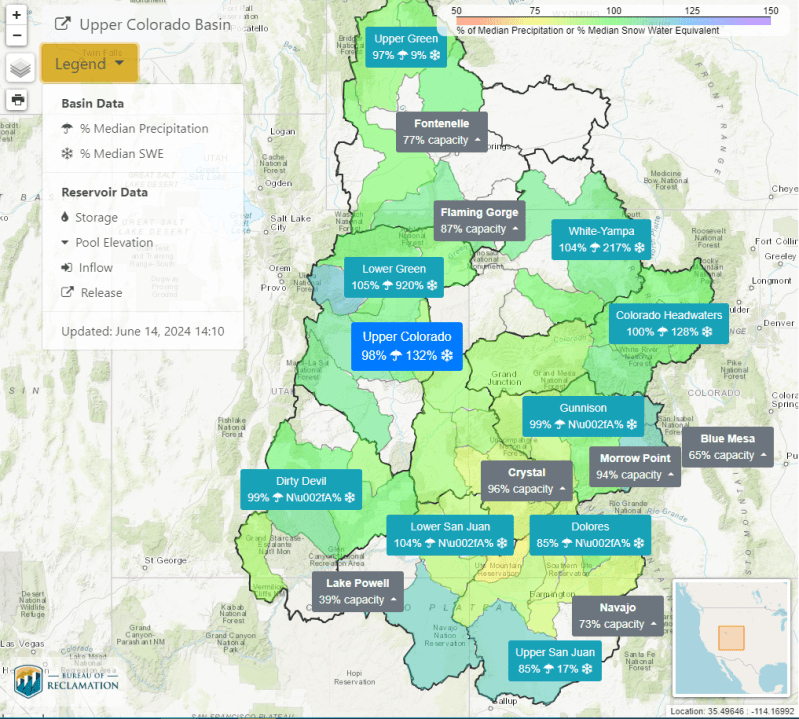LAS VEGAS (KLAS) – Large swings in water levels in Lake Mead are not expected to happen again over the next two years, according to projections released Friday by the U.S. Bureau of Reclamation.
For now, the forecasts updated monthly in Reclamation’s 24-month survey aren’t changing much. Lake Mead is expected to reach a low of 1,059.83 feet in November 2024, just 5 feet lower than its current level of 1,064.81 feet at noon Friday. These are measures of lake surface elevation – the number of feet above sea level.
From there, Lake Mead will rise to 1,066.08 feet in February 2025, and then drop to 1,052.62 feet by July 2025. Forecasts show the lake will reach 1,067.11 feet — the highest level in the 24-month forecast – in March 202.

How reliable are the predictions?
Predictions are not always accurate. They simply show the range of possibilities based on the best models available. Forecasts made a year ago missed the mark at Lake Mead by 9 feet.
The “most likely flow” numbers are used in generating the report each month. Alternative reports graph “minimum possible” and “maximum possible” data. This month’s report is remarkably similar to the forecasts published in May.

The 24-month study released in May 2023 predicted Lake Mead would be 1,058.20 feet in May 2024. But it actually hit 1,067.08 feet, according to the Bureau’s data. Looking ahead a year to May 2025, last year’s report is in line with the study released Friday: 1,056.01 feet (2023 projection) and 1,057.11 (2024 projection).
For Lake Powell, the most likely numbers were a little more outlandish.

Last year’s 24-month survey had Lake Powell reaching 3,586.94 feet in May 2024. It was actually about 18 feet lower, at 3,568.69 feet. Looking at May 2025, the 2023 projection expects Lake Powell to reach 3,592.95 feet. The current projection is 3,575.17.
If it seems like there’s something wrong with the math, remember that Reclamation controls how much water comes out of each dam on the Colorado River. After the water dropped nearly low enough to shut down power generation at Glen Canyon Dam in recent years, Reclamation has made it a priority to keep enough water upstream to prevent Lake Powell from dropping to that level again .
Nevada, Arizona and California have proposed a major change in the way the federal government makes decisions about water allocations. These states want the total water content of the Colorado River Basin to guide decisions, not just the surface levels of Lake Powell and Lake Mead — which could be manipulated by Reclamation.
A strong winter finish
Snowpack isn’t usually an interesting topic in early June, but sometimes Mother Nature saves the best news for last. The late season weather gave a small boost to snow water equivalent (SWE) measurements, especially in the Colorado River Headwaters region of the area that feeds the river that supplies 40 million people with the water they need.
In early April — usually the peak for SWE levels — Bureau statistics showed the Upper Colorado River basin was about 111% of normal. Two months ago, this was welcome news.

And it’s gotten better since then. On June 6, SWE levels were at 179% of the 10-year average. On Friday, this had fallen to 132% (blue box in the center of the map above).
In late April, when snowmelt typically occurs at a rapid and furious pace, SWE levels took an uncharacteristic turn for the better (bright blue line in the chart below):

Granted, the peak level in early April makes the biggest difference. But for a few weeks in late May to early June, the basin had a better water year than the year before (red line in the graph above). The 2023 winter helped Lake Mead and Lake Powell recover from a dry 2021-22 season.
The years 2019 and 2023 stand out as the best water years during the last decade.
#Lake #Meads #2year #outlook #5foot #drop
Image Source : www.8newsnow.com